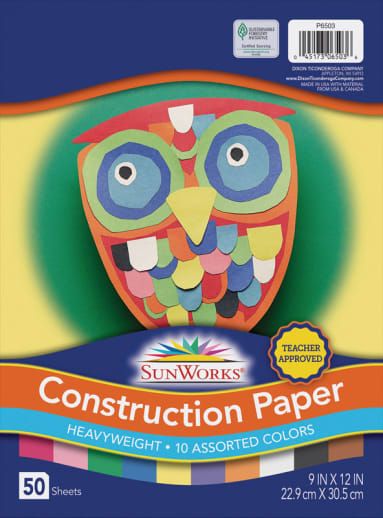SunWorks® Heavyweight Groundwood Construction Paper provides the best value in school grade construction paper. It is the perfect solution for school projects and other arts and crafts. It has bright and consistent colors, is slightly textured and cuts and folds evenly without cracking. Ten color assortment includes Scarlet, Black, Yellow-Orange, Brown, Pink, Violet, Blue, Holiday Green, White and Yellow. Recyclable.
SunWorks Construction Paper Assorted 9"x12"
Description
The Way They See It is Artistic Pursuits for 3-5 year-olds (and their parents). It's formatted a bit differently from the rest of the series in that it is written to the parent to help them understand children's artistic development, as well as develop a child's creativity and fine motor skills. The book is composed of two main parts: "The Nature of Children's Artistic Development" and "First Skills." Each lesson contains a portion written for the parent followed by a project for the child. The parent's portion will help them appreciate and foster the child's creative process while also offering practical advice for tackling the project. 36 projects include finger-painting, looking at the colors of the sky and coloring a picture of the sky with crayons, rolling or pressing textured objects into dough, drawing a picture from life, creating a paper bag puppet, drawing a plant, drawing a life-size outline of the child and coloring it in, adding horizon lines to a picture and much more. Many projects also include art reproductions and accompanying questions about the art for discussion. The last section of the book provides guidance for parents to teach their children how to use art supplies properly, such as scissors, pencils, crayons, markers, glue, tape, brushes and paint. For each tool, practical skill-building exercises are suggested. If you want to provide gentle but purposeful art instruction to your youngest students, this is an excellent resource to guide you.
With the arrival of the 3rd edition books, we have tracked down all of the recommended art supplies and have made complete packages for each book. Where specific brands are recommended by the author, we have included those exact items. In other cases, we have tried to match the art supplies as closely as possible to what Artistic Pursuits offers in their own art supply kits. - Jess
| Product Format: | Other |
|---|---|
| Grades: | PK-AD |
| Brand: | Sunworks |
| EAN/UPC: | 045173065036 |
| Length in Inches: | 12 |
| Width in Inches: | 9 |
| Height in Inches: | 0.375 |
| Weight in Pounds: | 0.6 |

